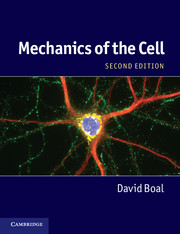Book contents
- Frontmatter
- Contents
- Preface
- List of symbols
- 1 Introduction to the cell
- 2 Soft materials and fluids
- Part I Rods and ropes
- Part II Membranes
- Part III The whole cell
- Appendix A Animal cells and tissues
- Appendix B The cell’s molecular building blocks
- Appendix C Elementary statistical mechanics
- Appendix D Elasticity
- Glossary
- References
- Index
Appendix D - Elasticity
Published online by Cambridge University Press: 05 June 2012
- Frontmatter
- Contents
- Preface
- List of symbols
- 1 Introduction to the cell
- 2 Soft materials and fluids
- Part I Rods and ropes
- Part II Membranes
- Part III The whole cell
- Appendix A Animal cells and tissues
- Appendix B The cell’s molecular building blocks
- Appendix C Elementary statistical mechanics
- Appendix D Elasticity
- Glossary
- References
- Index
Summary
Biological materials are generally soft, meaning that the shapes of objects made from them, such as strings and sheets, are moderately deformable under conditions commonly arising in the cell. Various aspects of the mathematical representation of deformations have been introduced in several chapters of this text (notably Sections 3.2, 4.2, 5.2, 6.2 and 8.2), although not in as much detail as would be found in a standard text on elasticity. Consequently, several calculations and fundamental results from continuum mechanics were quoted in this book without proof. To rectify this somewhat unsatisfactory situation, we develop in Appendix D:
the symmetry relations among elastic constants for materials with four-fold and six-fold symmetry in two dimensions,
the symmetry relations among elastic constants for materials with four-fold symmetry in three dimensions,
the relation between shape fluctuations and elastic constants.
There is considerable variation in the notation and analytic approaches adopted by the spectrum of disciplines that make use of continuum mechanics; the notational convention adopted here is close to that of Landau and Lifshitz (1986).
- Type
- Chapter
- Information
- Mechanics of the Cell , pp. 546 - 553Publisher: Cambridge University PressPrint publication year: 2012



